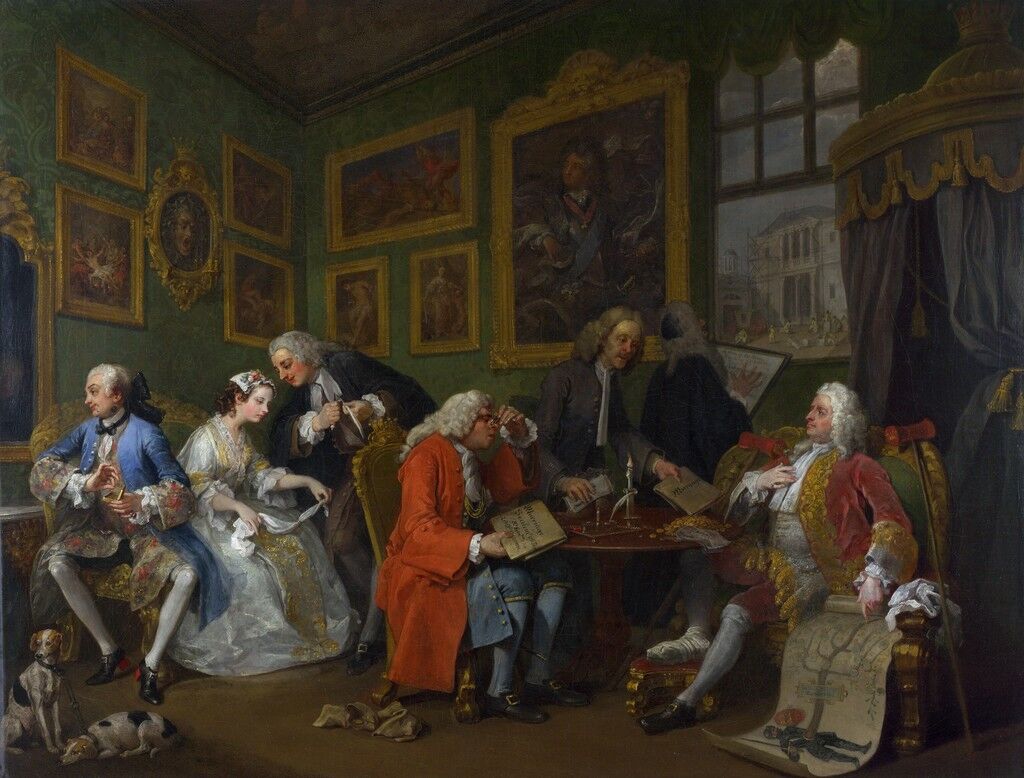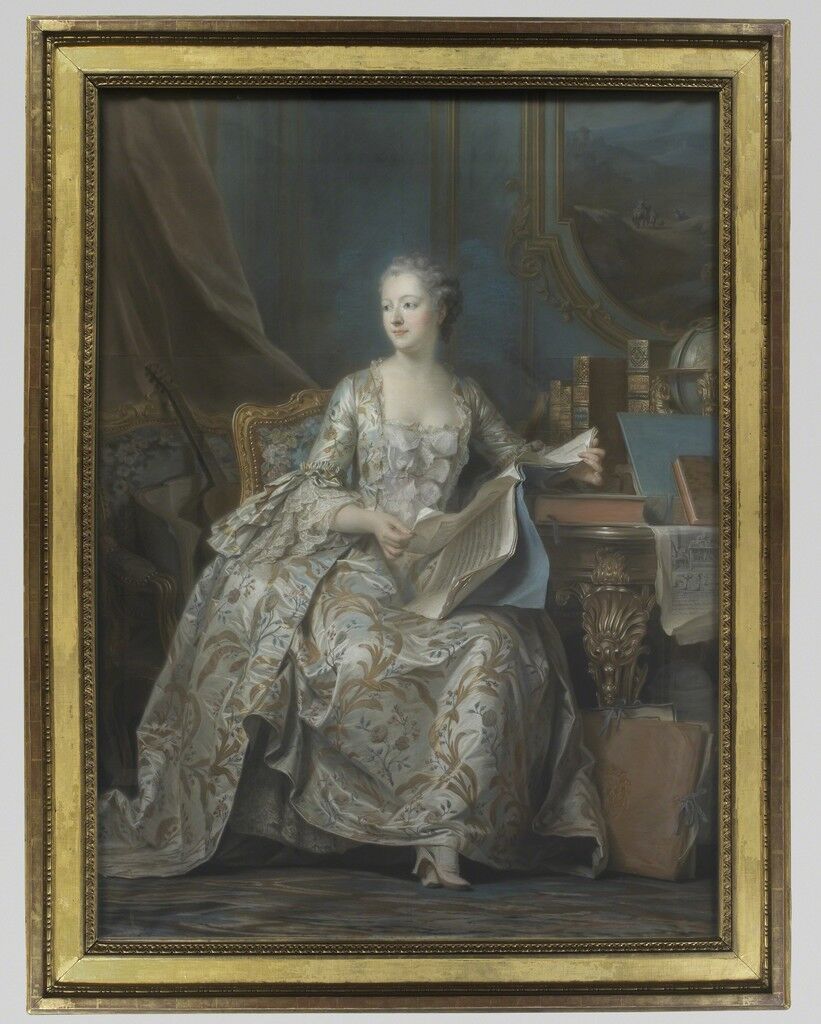Morality and the Classical Era
Morality in the Classical era focused on glorifying a high moral standard. These standards oftentimes stemmed from the French and American revolution, or classic stories, such as those about Sparta. Themes during this era included patriotism, sacrifice, and moral good, such as family. (Kljaich) If I were to speculate, I would imagine that these themes within artwork were used to enforce a cohesive unit during a time of turmoil, and bring people together on common ground. Between rapidly advancing science, multiple revolutions, and fading religious influence, one can easily see how divided the population may have been.
This painting is called Portrait of the Marquise de Pompadour by Maurice-Quentin de La Tour, completed in 1755. I would also assume that this painting was completed in France, because it is a painting of a famous Parisian, and was created by a French artist.
There is an obvious moral background to this piece. She is modestly dressed, studying music, and other educational pursuits. Beyond that, she is not wearing jewelry, nor is she surrounded by fancy things. She comes off as extremely humble and wise, which embodies many important moral values. Instead of indulging in a lavish lifestyle, she is committed to bettering her mind.
This culture of education was very important to France, and around this time, as they had one of the most well developed public systems, many of which were funded by the church during later years. In fact, there was a mandate that children attend Catholic school until they're 14. Imagine how important education is to our society. Going to school, and even pursuing higher education are seen as almost a moral right, and places certain individuals who do seek education as better than others. Therefore, it is safe to conclude that pursuing scholarly arts was a moral good in French society, as it is portrayed here.
I think this painting is absolutely stunning. I particularly like the muted use of color. A lot of colors have certain associations, (red with promiscuity, purple with wealth etc) so by muting everything, you really have to focus in on the art itself. The painting also seems blurred, giving it a dreamlike focus that makes it very calming to me.
I would absolutely own this piece. I think that it's very delicate, and unique when compared to the other Classic era art that I found while researching my blog. It's very calming to look at, and I would enjoy having it in my collection. This painting was made in order to show off the subjects knowledge in worldly arts, which I find to be very inspiring, as an academic myself.
This final piece is called Oath of the Horatii, painted by Jacques-Louis David in 1785. As with my analysis on his previous piece in this blog, he is a French artist, so I will assume that this painting was done in France, although the article does not specify.
This image beautifully exemplifies the moral standards of the time. It represents three brothers swearing to defend Rome, a patriotic and brave act. Essentially, these brothers are taking up arms to fight a symbolic battle, as opposed to a full-scale war between two entities.
Artistically, this is very well represented by the compositional choices. The three men seem to be in a darker light than the other figures, casting them as extremely serious and somber. The figures in the back are mourning, according to the Smarthistory article, these are their family members. The sense of sacrifice is obvious with the harsh contrast between the men's stoicism and the womens upset. The final interesting point is the beam of light highlighting the man handing them the swords. It makes him appear to be some form of messenger, and reminds me of the Godly imagery we have previously viewed, where the focus was highlighted as if shone on by heaven.
I wouldn't personally own this piece. I think it's very beautiful, and is technically well done, but I am a pacifist and I don't like to keep imagery of violence or war around. I think the backstory around it is very lovely, although I don't have time to go more into depth then what I already have, I suggest reading the smarthistory article, as it explains it pretty thoroughly.
Citations
Editorial, Artsy, and Rachel Lebowitz. “10 Rococo Artworks You Should Know.” Artsy, 29 May 2018, www.artsy.net/article/artsy-editorial-10-artworks-defined-rococo-style.
“Education Before And After French Revolution History Essay.” UKEssays.com, www.ukessays.com/essays/history/education-before-and-after-french-revolution-history-essay.php.
Kljaich, Lisa. “Classical Influences and Architecture.” Art 200x, art200.community.uaf.edu/classical-influences-and-architecture/.
Kljaich, Lisa. “Neoclassical Traits.” Art F200X, art200.community.uaf.edu/wp-content/uploads/sites/654/audio_transcripts/neoclassicaltraits.mp3.pdf.
McCoy, Dr. Claire Black, and Dr. Claire Black McCoy. “Jacques-Louis David, Oath of the Horatii.” Smarthistory, smarthistory.org/jacques-louis-david-oath-of-the-horatii/.
Reiley, Audrey. “Napoleon Crossing The Alps.” The Odyssey Online, The Odyssey Online, 16 Oct. 2019, www.theodysseyonline.com/napoleon-crossing-alps.




June,
ReplyDeleteAll of the pieces you used for your blog are absolutely stunning, but my favorite is Portrait of the Marquise de Pompadour. The overall delicacy in this painting is very pleasing to the eye, even without the use of prominent color like you mentioned. I like how you took into consideration that she isn't wearing any jewelry or flashy colors like most women are depicted and how that may be because the artist wanted its viewers to see more of a scholarly side to her. I also really like that you talked about the importance of education in France, even way back in the 1700's. I feel like women and education together aren't often shown in art from those times, so it's refreshing to see this painting. Thank you for sharing!
I appreciate your comparison of these works of art. I agree with the muted description on how these paintings look with their color usage. In "The Settlement by William Hogarth" the asymmetry layout in people in the room was a really great catch and I like how you related it to loneliness. Lastly, the humbleness presented by the second painting was really intriguing, the color also doesn't show vibrant "rich" color to exemplify wealth so the usage of darker colors really make it relatable to morality and contentment.
ReplyDeleteI am not personally such a huge fan of the paintings that look like a screenshot of a film. To me, they seem very rigid and "educational," which isn't a bad thing but doesn't appeal to me artistically. I do love the second painting and the info about your topic is so interesting. These paintings definitely reflect ideas about morality of the time. I liked how you analyzed the woman's appearance and dress to assess the moral inspiration behind the piece. I agree that she presents as modest and wise, from her clothes to her expression. It is always interesting to see a woman presented in independence as scholarly and musical, as there wasn't as much access to these for women at the time. I wonder if this reflected the educational pursuits of more royal women at the time?
ReplyDeleteOrthodontic care has evolved far beyond traditional metal braces. Many people now choose lingual braces—also known as hidden braces or braces behind the teeth—for a discreet way to straighten their smile. But what exactly are lingual braces, how do they work, and what should you expect if you choose them? In this guide, we’ll cover everything you need to know, including their benefits, drawbacks and Lingual braces cost,and how they compare to traditional braces—plus why they’re often called “braces inside the teeth.
ReplyDeleteCan Stress Cause Nosebleeds
ReplyDeleteCardiac stress test cost
Benefits of Black Tea
healthiest fast food